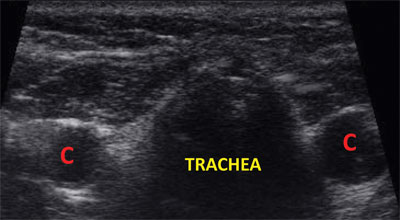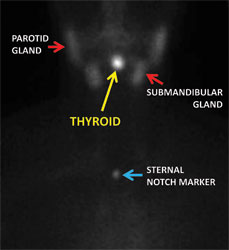The case of the missing thyroid gland
A 36-year-old female was referred for abnormal thyroid tests with a total thyroxine of 17.7 mcg/dL — a normal range is 5.1 mcg/dL to 11.4 mcg/dL — and thyroid-stimulating hormone of 0.08 mIU/L -— a normal range is 0.35 mIU/L to 4.9 mIU/L.
As a child, she was much smaller, but in adolescence she started to grow to her adult height of 5’3”. Her menstrual periods started at age 13 years. At age 17 years, she was diagnosed as “mildly” hypothyroid during an evaluation for juvenile myoclonus. She was started on levothyroxine therapy, with many dose changes over the years. She admitted to missing many of her tablets for weeks at a time, resulting in her current dose of 200 mcg levothyroxine daily.
At the time of her first appointment in the endocrine clinic, she was an alert, intelligent young woman with normal skin texture, no periorbital edema, with normal relaxation phase of her deep tendon reflexes, but a thyroid could not be palpated. Thyroid tissue was not seen by ultrasound (Figure 1).

Figure 1. Ultrasound of the thyroid bed. Transverse image of the thyroid bed shows the absence of thyroid between the carotid arteries.
Source: S. L. Lee, MD, PhD, reprinted with permission
She was asked to temporarily stop her levothyroxine for 3 weeks for a nuclear thyroid scan. When she returned 3 months later, she had not done the scan or restarted her thyroid hormone. Her TSH was 91 mIU/L with a free T4 index of 1.1 (reference range: 1-4), thyroid peroxidase antibody of 1.3 IU/mL (negative: <.5), thyroglobulin antibody <.1 IU/mL (negative: <.4.1), and thyroglobulin of 2.7 ng/mL (normal: 4-40).
Location of the gland
In the presence of an elevated TSH, the low thyroglobulin level suggested an absence of thyroid tissue. A technetium-99m thyroid scan was ordered with backed-off views of the mediastinum (Figure 2).

Figure 2. Technetium-99m thyroid scan with anteroposterior image, including the head, neck and anterior mediastinum. Intense isotope trapping in thyroid tissue located in the area of the oropharynx (yellow arrow). The isotope is excreted by the parotid and submandibular salivary glands (red arrows). Sternal notch marker (blue arrow).
An intense area of isotope trapping was located in the area of the mouth on both anteroposterior (Figure 3A) and lateral (Figure 3B) views. The patient was asked to extend her tongue forward, which resulted in opening the posterior pharynx and moving forward of the lingual thyroid located at the base of the tongue (Figure 3C).
Congenital hypothyroidism occurs in one in 2,000 to 4,000 births in North America. In 85% of the cases of congenital hypothyroidism, the cause is thyroid dysgenesis, including thyroid agenesis (congenital absence of a thyroid), hypoplasia (congenitally small thyroid) and ectopy (thyroid tissue in an abnormal location). By 10 weeks of gestation, the thyroid gland descends from the base of the tongue, the foramen caecum, through the thyroglossal duct to the lower anterior neck. A failure to migrate normally may leave part or all of the thyroid tissue at the base of the tongue or any position along the thyroglossal tract. Nearly all (90%) of ectopic thyroid glands are found at the back of the tongue (lingual thyroid). The prevalence of lingual thyroid is one in 100,000 and occurs more often in females than males (3:1 to 7:1). Most cases of thyroid dysgenesis are sporadic. Rare cases of thyroid dysgenesis have been associated with mutations in PAX8, thyroid transcription factor-2 (TTF-2, also called FOXE1), and transcription factors NKX2.1 (formerly called TTF-1) and NKX2.5.
Thyroid dysgenesis can be evaluated by scintigraphy with either technetium-99m or I-123. Thyroid tissue can be identified by ultrasonography in infants, but it is not as reliable as radionuclide imaging in identifying thyroid dysgenesis. Ultrasonography with color-flow Doppler detected ectopic thyroid tissue in 90% of infants with congenital hypothyroidism and ectopic tissue detected on radionuclide imaging.
Serum thyroglobulin measurement is unlikely to add more information than radionuclide imaging because of the overlap of levels in infants with congenital hypothyroidism: thyroid agenesis (mean 12 ng/mL, range 2-54 ng/mL), ectopic thyroid tissue (92 ng/mL, range 11-231 ng/mL), and goiters (226 ng/mL, range 3-425 ng/mL) with a normal range of 20 ng/mL to 80 ng/mL. In our case, the low thyroglobulin level with an elevated TSH confirmed the lack of thyroid tissue. Negative thyroid antibody levels suggest the absence of autoimmune thyroid destruction. The nuclear thyroid scan confirmed an ectopic lingual thyroid.

Figure 3. Technetium-99m scintigraphy of the head. A. Anteroposterior image showing trapping of isotope in a lingual thyroid (red arrow). B. Lateral image of the head. C. Lateral image of the head with tongue extended. Faint excretion of isotope in the nasopharynx (green arrow). Stronger excretion of isotope by the salivary glands (blue arrow). The trapping in the salivary glands (blue arrow) and the lingual thyroid (red arrow) overlap in the lateral views. Protrusion of the tongue moves the lingual thyroid anteriorly and an air column in the posterior pharynx is seen (yellow arrow).
Detection, treatment
Ectopic thyroid glands have reduced function and are usually found during newborn screening for congenital hypothyroidism. Occasionally, adequate thyroid hormone secretion occurs for normal growth and development during childhood, and then hypothyroidism is found during adolescence or adulthood. Adult diagnosis of lingual thyroid is usually detected because of dysphagia, airway obstruction or dysphonia but rarely identified simply, as with our patient, because of hypothyroidism.
The exact cause of hypothyroidism in this case remains unclear. Treatment of a lingual thyroid depends on its size and symptoms. Patients should be treated with thyroid hormone to maintain a TSH in the lower part of the normal range to minimize goitrous enlargement. Surgery is indicated if there are complications such as hemorrhage or suspected malignancy. It has been suggested that thyroid ablation with radioactive iodine is an alternative approach. In the present case, the absence of local complications means that levothyroxine therapy is the only treatment required.
References:
- Karakoc-Aydiner E. Eur J Endocrinol. 2012;166:43-48.
- Neinas FW. Ann Intern Med. 1973;79:205-210.
- Tojo K. Intern Med. 1998;37:381-384.
